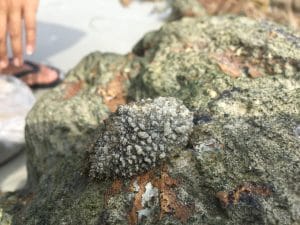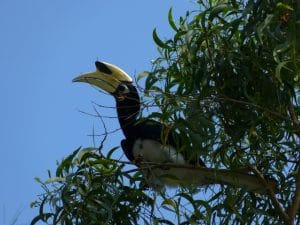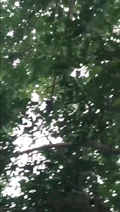Promotions
A Glimpse at Telunas Wildlife
by Andika Uhud Suryo
There’s no question that the land and seascapes at Telunas Resorts are stunning. But with a keen eye and a little luck, you may also have the opportunity to run into some of our local inhabitants that call Telunas home. In honor of World Environment Day, here is a peek at some of our favorite Telunas animals!
1. Soldier Crabs


Photo by: (left)Telunas Resorts Archive, (right) Bella Lopez
Soldier crabs are some of the tiniest animals found on our Telunas beach, and yet, they are some of the favorites among our guests! These crabs are most commonly seen moving in masses (armies, actually!) along the water’s edge, just as the tide is going out. The moist sand of the receding tide is covered by nutrients left behind by the ocean water. Soldier crabs take mouthfuls of this sand and roll it around in their mouths for a while, similar to the way that we would chew a piece of gum. When the “flavor” is gone, they spit out a perfect little ball of clean sand. As that mass of soldiers moves along the beach together, a beautiful pattern of tiny sand balls are left behind. When the tide comes in, soldier crabs bury themselves by creating little sand igloos with air pockets inside. They stay inside these until the next tide cycle where the process begins all over again!
2. Pacific Swallow

Photo by: Telunas Resorts Archive
One of the most beautiful birds at Telunas also happens to be one of the most common! Without fail, every morning you can see the Pacific swallows lining the railings around the guest bungalows. Though it is easy to find, it is a bit shy, so don’t expect to get too close. It is a fast flyer and doesn’t stay in one place for too long!
3. Monitor Lizard

Photo by: Jennie Christensen
This carnivorous, dragon-like reptile is relatively common to see at Telunas, as their dark scales make them easy to spot on our white sand beach. With few predators in our area, monitor lizards happily trudge along the water’s edge at low tide, sucking up small crabs. When the tide is high or the crabs aren’t out, we often find them near our trash incinerator, hoping for a scrap of leftover food. They are quite scared of humans and won’t let you get too close. Though many species of monitor lizards are too large and heavy to climb trees, ours do! Occasionally, you might find one high up in a tree, either hiding or eating insects.
4. Onch Slugs

Photo by: Bella Lopez
Can you spot the animal in this photo? The onch slug is a master of disguise to avoid predators but can be found along the moist rocky areas of the Telunas beach if you look very closely. These are air-breathing marine slugs that feed on algae growing on the rocks. It is believed that many species leave a mucus trail as they feed, so that they can find their way back home before the tide rises again1.
5. Carpet Anemone

Photo by: Bella Lopez
This isn’t just a gooey blob of jelly! Let me introduce you to another of our marine organisms, the carpet anemone. This animal belongs to the jellyfish family and is covered with tiny, sticky tentacles. They tend to stay fairly stationary, waiting for their prey to accidentally walk across them. When the prey gets stuck, the anemone slowly moves it to the center of its body where the mouth/stomach is located. Some species can grow up to a meter in diameter, though the average size of a carpet anemone at Telunas is only about half that size2.
6. Spotted-wing Fruit Bat

Photo by: Bella Lopez
The spotted-wing fruit bat is the smallest of all fruit bats. These little guys are almost always found hanging in tight clusters from the bottoms of palm leaves, however, they can also be found under man-made structures. We found this little family in a building near the jungle’s edge, close to their food source of fruit. This kind of bat is not too common to find at Telunas, but to date, they have never been seen in Singapore3!
7. Stork-Billed Kingfisher

Photo by: Bella Lopez
The stork-billed kingfisher is one of the reasons you may not need an alarm clock at Telunas. At first breath-taking glance, you might expect a tropical beauty like this to have a more gentle call when she opens her beak. Instead, she tends to produce a more startling and cackly song as she sits on low-lying branches of mangroves (or support beams under our jetty), carefully watching the water for a fish passing by. This skilled fish hunter is most commonly seen during our clear water season, though she has also been known to hunt successfully in murky waters as well. Bring a good camera if you want to get a good photo of this type of kingfisher, as she isn’t brave enough to let you get good shots with a basic phone camera. If you get too close, her most common escape route is a low, diagonal flight across the Telunas bay to her hidden nest in the coastal jungle.
8. Oriental Pied Hornbill

Photo by: Telunas Resorts Archive
It is always a treat to come across our little family of oriental pied hornbills at Telunas. They are typically spotted first by sound. At first, you might think a monkey or a large chicken was falling through the tree branches. Due to its size and general clumsiness, this hornbill can’t hide itself too well in the trees unless it stays very still. The strange bony structure on the top of its bill is hollow and is called a “casque.”4 It is useful for balance and for reverberating its less-than-melodious “kek-kek-kek” call5. Currently, we have 3-4 adult hornbills in our immediate vicinity, though they seem to be somewhat seasonal, perhaps moving further down the beach during certain parts of the year.
9. Colugo
………………………….

Images by: (left) Bella Lopez, (right) Jennie Christensen
Only those with a sharp eye (or a lot of luck!) will have a chance to see the elusive tree-dwelling colugo. They are herbivorous and primarily nocturnal, so a daytime photo like this is quite rare6. This little guy was so high up in the tree that the photo was taken by a phone camera through a pair of binoculars. What is the one of the most unique features of this cuddly-looking mammal? Check out that GIF above, witnessed by a group of Telunas staff members. No one was more shocked than they were!
10. Asian Small-clawed Otter

Photo by: Tornita Harahap
Over the past few decades, the Asian small-clawed otter has become increasingly scarce as pollution and habitat destruction have been on the rise, as well as the online commercial sale of these animals as pets. As a result, this species is now listed as vulnerable and at a high risk of extinction in the wild7. However, somehow a little family of these guys have found their way to the waters around Telunas! Though we don’t see them often, they pop up periodically at either of our resorts, typically when there is a low tide in the mornings or at dusk, where they are found feasting on their favorite foods: crabs and mudskippers. This is certainly a rare sight, but one we hope all of our guests get to experience!
Sources:
1http://tidechaser.blogspot.com/2012/05/onch-slug-onchidiidae-singapore.html
2https://www.liveaquaria.com/product/602/?pcatid=602
3https://www.ecologyasia.com/verts/bats/spotted-winged-fruit-bat.htm
4https://www.birdwatchingdaily.com/beginners/birding-faq/julie-craves-explains-purpose-hornbills-bills/
5https://indianbirds.thedynamicnature.com/2017/03/oriental-pied-hornbill-anthracoceros-albirostris.html
6https://www.ecologyasia.com/verts/mammals/colugo.htm
7https://www.researchgate.net/publication/332440007_Asian_Small-clawed_Otter
